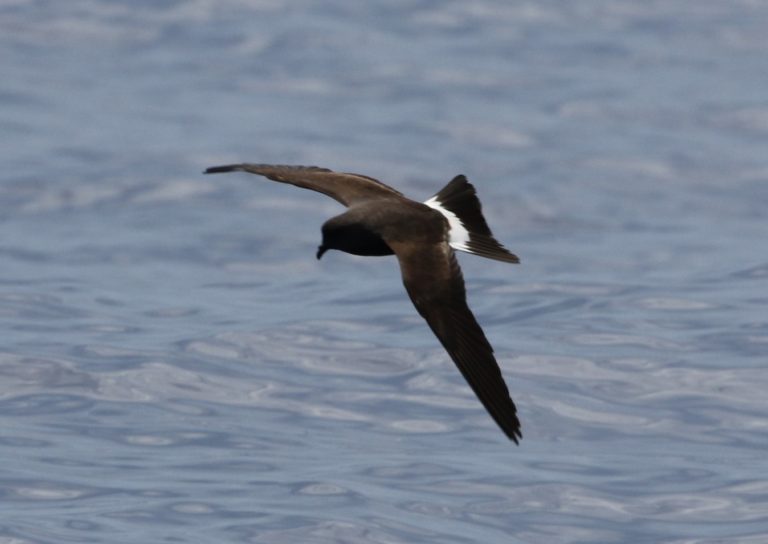The Avitourist’s Guide to Kauai
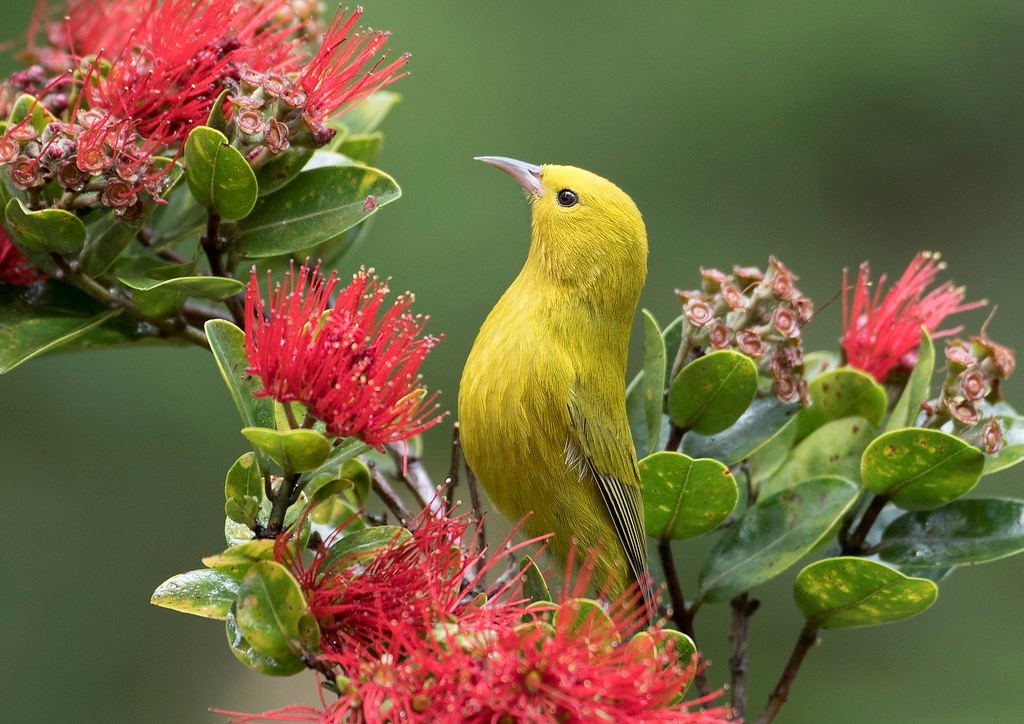
The Kauai endemic Anianiau. © Jim Denny
Nicknamed the Garden Isle, Kauai is the lushest of the Hawaiian Islands, and the only one of the main islands whose avifauna was spared from the introduction of mongoose, so it is disproportionately productive. With six remaining bird species found nowhere else, Kauai is second to the Big Island in avian endemics. Those that have survived into the 2020s are the Kauai Elepaio, the Puaiohi, the Akikiki, the Anianiau, the Akeke’e, and the Kauai Amakihi.
Highlands
All of Kauai’s endemics occur in the Alakai Wilderness (a.k.a. Alakai Swamp, Site #1 on the map below)—but only three of them (the elepaio, amakihi, and Anianiau) can be found reliably in accessible areas, a fourth (the Akeke’e) is still found regularly but less often and less predictably, and the remaining two are rarely observed by anyone who is not engaged in biological field projects. The four “findable” endemics can also be found at the adjacent Koke’e State Park (Site #7), although the Akeke’e appears to be following the Akikiki’s retreat into the wilderness, and the same fate is foreseeable (but does not yet seem inevitable) for the Anianiau.
Endemic Birds of Kauai
Kama’o † / Puaiohi / Kauai O’o † / Kauai Elepaio / Akikiki / Kauai Nukupu’u † / Kauai Akialoa † / Anianiau / Kauai Amakihi / Akeke’e
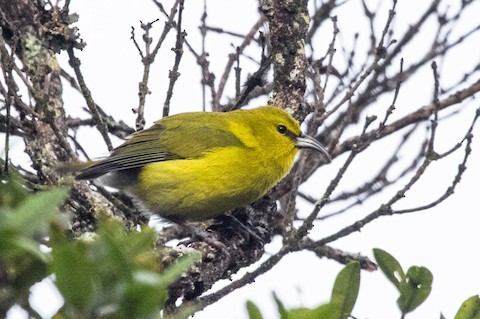
The Kauai endemic Kauai Amakihi. © Michael Hooper
Four additional Kauai endemics are known to have survived into the late 1900s but not beyond: the Kauai Akialoa until around 1970, the Kama’o and Kauai O’o until around 1987, and the Kauai Nukupu’u until somewhere between the 1960s and the 2000s. Finally, a widespread Hawaiian endemic that persisted on both Kauai and the Big Island into the 1980s, and appears to have persisted slightly longer on Kauai, the O’u, was last seen in 1989. Each of these five now presumptively extinct species is believed to have made its last stand in the Alakai Swamp; which is also the apparent trajectory of the Akikiki and perhaps also of the Akeke’e.
Other Hawaiian Endemics Found on Kauai
Wetlands
Kauai supports populations of all Hawaiian endemic freshwater aquatic birds that remain in the main islands. The best place to find Hawaiian Duck is Hanalei National Wildlife Refuge (Site #3), which is also reliable for the other endemic waterbirds: Hawaiian Goose, “Hawaiian Gallinule” (a distinct form of Common Gallinule), Hawaiian Coot, and “Hawaiian Stilt” (a distinct form of Black-necked Stilt). These birds are all fairly common and widespread in Kauai’s lowlands, and can be found at several other sites as well, including Kawai’ele State Waterbird Sanctuary (Site #5), Lihue (Site #9), and Poipu (Site #10).
Seabirds
Kilauea Point National Wildlife Refuge (Site #6) is Hawaii’s most accessible seabird colony, with nesting Yellow-billed Tropicbird, Red-tailed Tropicbird, Laysan Albatross, Wedge-tailed Shearwater, and Red-footed Booby. Also present are Great Frigatebird, Brown Booby, and a few pairs of Newell’s Shearwater and Hawaiian Petrel. One or two Kermadec Petrels have occurred here from time to time since at least 2011.
A short drive west of Kilauea Point, at the end of the road, Ha’ena State Park (Site #2) is the most reliable site on Kauai for “Hawaiian Noddy” (a distinct form of Black Noddy that seems likely to be recognized as a separate species).
Oceanic birds can also be seen at a few other prominent coastal headlands along the southern and eastern coasts of Kauai, especially at Makauena Point near Poipu (Site #10), where it is sometimes possible to see Hawaiian Petrel, Bulwer’s Petrel, and Newell’s Shearwater. There are additional seawatch points at Hanapepe (Site #4) and Lihue (Site #9).
For even greater seabird diversity, a boat trip across Kaulakahi Channel to Lehua Islet (Site #8) has the potential to yield all of the birds mentioned above plus several more rarely encountered anywhere without a special expedition, such as “Hawaiian Storm-Petrel” (a potentially distinct form of Band-rumped Storm-Petrel), Tristram’s Storm-Petrel, Black-winged, Cook’s, and Mottled Petrels, Masked Booby, and Blue Noddy.
Exotics
Like the other major islands, Kauai has its share of exotic (i.e., non-native) species, including two (Red Junglefowl and Greater Necklaced Laughingthrush) that are not established anywhere else in the U.S., and another (Western Meadowlark) that is not established elsewhere in Hawaii. There are also a few introduced species that can be found more easily on Kauai than on some of the other islands: Erckel’s Francolin, Japanese Quail, Rose-ringed Parakeet, White-rumped Shama, Chinese Hwamei, and Chestnut Munia.
Kauai – Orientation Map
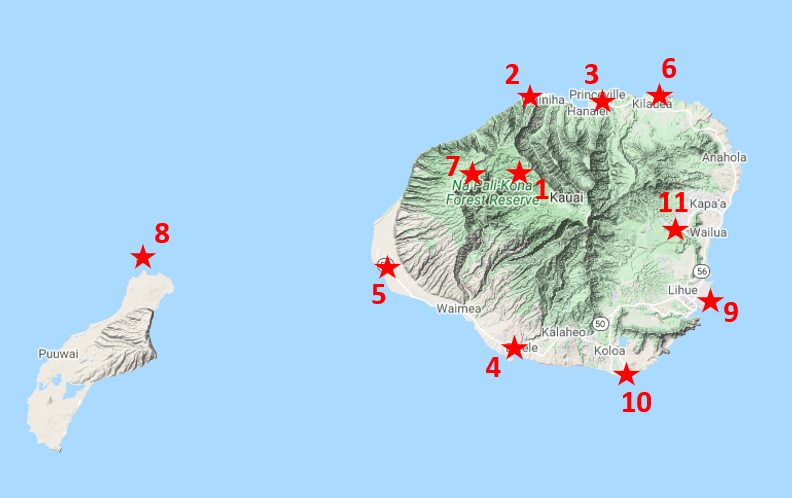
Planning a Visit
Kauai is not a large island, but it is large and complex enough that visitors need to decide beforehand where to allocate their time. The endemic landbirds are essentially confined the northwestern highlands, whereas the endemic waterbirds can be seen throughout the lowlands. The best seabird sites are along the northern and southern shores. Finally, certain introduced birds are best sought in the eastern lowlands.
Eastern Shore
The vast majority of visitors to Kauai arrive at the airport in Lihue, and a very large proportion find accommodations there or nearby. This approach has the inherent advantages of being economical and preserving logistical flexibility to visit the northern and southern shores and the northwestern mountains. Except for those who have a specific and compelling reason to chose another part of the island as their base, the eastern shore is probably the best option for most visitors. The eastern shore is also the most likely place to find one of Kauai’s more difficult specialties, the introduced Greater Necklaced Laughingthrush.
Lihue (Site #9): Gateway to Kauai, Lihue is a convenient place for arriving and departing visitors to find some of the island’s specialties. The Hawaiian endemic waterbirds Hawaiian Goose, Hawaiian Duck, “Hawaiian Gallinule”, Hawaiian Coot, and “Hawaiian Stilt” can be found on resort grounds adjacent to the airport. Nearby Ninini Point provides opportunities to see pelagic species including Hawaiian Petrel, Wedge-tailed and Newell’s Shearwaters, Brown and Red-footed Boobies]. Southwest of town, the Hule’ia Valley is one of the better spots to search for Greater Necklaced Laughingthrush, Along with White-rumped Shama and Chinese Hwamei.
Wailua River Valley (Site #11): The Wailua River Valley is a scenic area frequented by the many tourists who stay along Kauai’s eastern shore in Lihue or the Kapa’a area. It has been a consistent site for both of the exotic species that are unique to Kauai, Red Junglefowl and Greater Necklaced Laughingthrush, and also good for other exotics including Rose-ringed Parakeet, White-rumped Shama, Japanese Bush-Warbler, Chinese Hwamei, and Chestnut Munia, and waterbirds such as Hawaiian Duck and Hawaiian Coot.
Northern Shore
Once they are temporarily housed on Kauai, the most popular direction for visitors to tour is north. Even the non-adventurous are drawn to the Na Pali Coast, although fairly few venture beyond the first stretch of trail. Kilauea Point, the dramatic setting of an old lighthouse and a large seabird colony, naturally attracts attention. Traffic congestion is a serious obstacle to efficient travel in this direction, and access is increasingly rationed through reservation requirements for the popular sites—measures that have simply become necessary.
Kilauea Point National Wildlife Refuge (Site #6): Kilauea Point is one of the most readily observable seabird colonies in the U.S., with nesting Yellow-billed Tropicbird, Red-tailed Tropicbird, Laysan Albatross, Wedge-tailed Shearwaters, and Red-footed Booby. Hawaiian Goose also nests in the refuge and ongoing efforts to translocate Hawaiian Petrel and Newell’s Shearwater have succeeded thus far, as the shearwater nests in small numbers and petrel sightings have increased. Other notable species that are always or often present include Great Frigatebird and Brown Booby, and Kermadec Petrel has occurred sporadically in recent years.
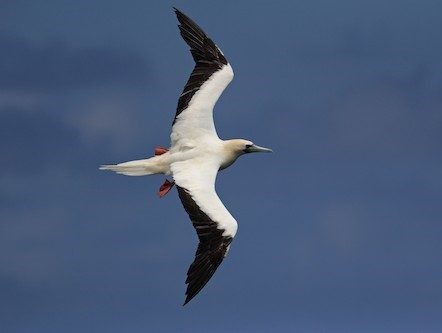
Red-footed Booby at Kilauea Point National Wildlife Refuge. © Ben Lagasse
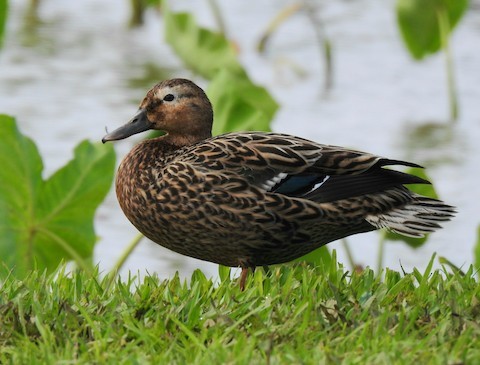
Hawaiian Duck at Hanalei National Wildlife Refuge. © Joel Gilb
Hanalei National Wildlife Refuge (Site #3): On Kauai the highest diversity of birds occurs in the Hanalei Valley, a National Wildlife Refuge since in 1972. It was protected as a nesting area for Hawaiian Duck, Hawaiian Coot, “Hawaiian Gallinule”, and “Hawaiian Stilt”, and for its importance to migratory waterfowl and shorebirds. It is the only site that hosts breeding populations of five endemic Hawaiian waterbirds—i.e., the previous four plus Hawaiian Goose, which established itself in Kauai’s lowlands through an unintentional release of captive birds in the 1990s.
Ha’ena State Park (Site #2): Driving counterclockwise on Kauai, the end of the line is Ha’ena State Park, which includes Ke’e Beach and the head of the famous Kalalau Trail along the Na Pali Coast. The beach areas and seaside cliffs along the trail good for seabirds—especially “Hawaiian Noddy”, which is highly localized and hard to find elsewhere on Kauai, but also Yellow-billed Tropicbird, Red-footed and Brown Boobies, and Great Frigatebird. Most other birds present can be found more easily elsewhere, but the park is a notably reliable site for Red Junglefowl.
Southern Shore
The southern shore of Kauai is drier and less crowded than the northern and eastern shores. This part of the island is more relaxed and less challenging to visit. For dedicated birdwatchers, the most interesting opportunities are seaward. Makahuena Point, near Poipu, is among the best locations to see deep-water species from land and Port Allen, near Hanapepe, is the best place to launch an offshore excursion into Kaulakahi Channel, and ideally to Lehua Islet, where several rarely seen species are plausible targets.
Poipu (Site #10): The heart of Kauai’s tourism industry, Poipu hosts a large fraction of visitors to the island. The expansive resort landscape is productive for waterbirds and exotics, and there are several promontories—most famously Makahuena Point—that are well-placed for observing seabirds, which regularly include: Yellow-billed Tropicbird, Laysan Albatross, Hawaiian and Bulwer’s Petrels, Wedge-tailed, Sooty, and Newell’s Shearwaters. Brown and Red-footed Boobies, Great Frigatebird, and Sooty Tern. Species seen less often, but apparently regular, include: “Hawaiian Storm-Petrel” and Buller’s and Christmas Shearwaters.
Hanapepe (Site #4): The Hanapepe Peninsula is among the best sites on Kauai for land-based observation of seabirds. Species regularly seen from its headlands include Yellow-billed Tropicbird, Laysan Albatross, Hawaiian Petrel, Wedge-tailed and Newell’s Shearwaters, Brown and Red-footed Boobies, and Great Frigatebird. A pair of large ponds typically host Hawaiian Duck and “Hawaiian Stilt” in addition to various seasonal migrants, and fields and brush provide habitat for several introduced landbirds.
Kawai’ele State Waterbird Sanctuary (Site #5): The wetland restoration project at Kawai’ele is a good place to see Hawaii’s endemic waterbirds: especially “Hawaiian Gallinule”, Hawaiian Coot, and “Hawaiian Stilt”, and often Hawaiian Goose and Hawaiian Duck. As a habitat oasis beside the ocean, it regularly attracts migratory waterfowl and shorebirds, sometimes including rarities from Asia. The surrounding fields and brushland support many introduced species, including Black Francolin, and the coastal access at Kekaha can be productive for seabirds.
Lehua Islet (Site #8): Beside the northern end of Ni’ihau, the ancient cinder cone of Lehua is an adventure destination for divers and the platform for an unmanned nautical light. Through many decades of rat infestation, Lehua remained a significant nesting site for several seabirds, including Red-tailed Tropicbird, Laysan and Black-footed Albatrosses, Bulwer’s Petrel, Wedge-tailed and Newell’s Shearwaters, Brown and Red-footed Boobies, and “Hawaiian Noddy”, and the most accessible location in the U.S. where Blue Noddy was a reasonable possibility. With the removal of the rats, seabird populations are expected to grow and diversify. The route to Lehua is through Kaulakahi Channel, which has produced sightings of rarities such as Tristram’s Storm-Petrel, and Black-winged, Cook’s, and Mottled Petrels.
Northwestern Highlands
The essential site for Kauai’s endemic birds is Koke’e State Park, above Waimea Canyon. The adjacent Alakai Wilderness preserves a few additional critically endangered rarities, but is effectively inaccessible to all but the most extreme backcountry expeditionists. Even just a daytrip to the state park requires advance preparation for a reasonable hope of seeing the less critically endangered Kauai endemics.
Koke’e State Park (Site #7): Koke’e State Park is the most accessible site to search for Kauai’s endemic birds: three of which are still reliably seen there: Kauai Elepaio, Anianiau, and Kauai Amakihi. A fourth, the Akeke’e, has become scarce and unpredictable. The other two surviving Kauai endemics—the Puaiohi and Akikiki—are mostly confined to the Alakai Wilderness, a forbiddingly muddy realm of cloud forest and peat bogs to which Koke’e is the gateway. The Koke’e area is also among the more reliable sites for several introduced species, including Erckel’s Francolin, Red Junglefowl, White-rumped Shama, and Chinese Hwamei.
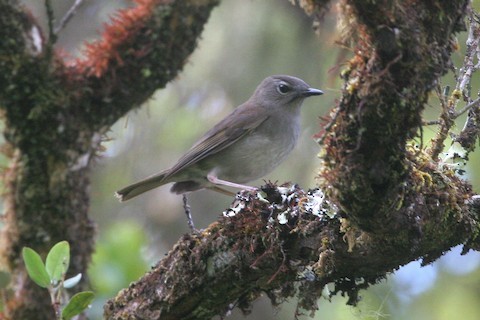
Puaiohi in the Alakai Wilderness Preserve. © Eric VanderWerf
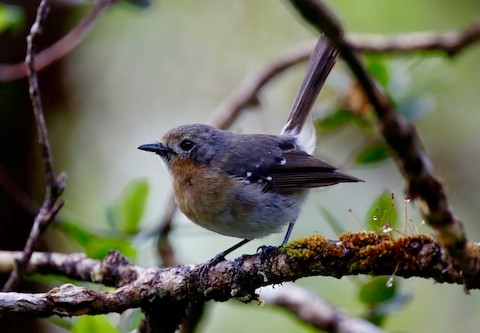
Kauai Elepaio along the Pihea Trail at Koke’e State Park. © Timo Mitzen
Alakai Wilderness (Site #1): The Alakai Plateau in Kauai’s northwestern highlands is the only place where one could reasonably hope to find three critically endangered species: the Puaiohi, Akikiki, and Akeke’e. Another three Kauai endemics inhabit the Alakai but are not restricted to it: the Kauai Elepaio, Anianiau, and Kauai Amakihi. The Alakai has also become a burial ground, where in the late 1900s five species drew their final breaths on Earth: the Kama’o, Kauai O’o, O’u, Kauai Nukupu’u, and Kauai Akialoa.
